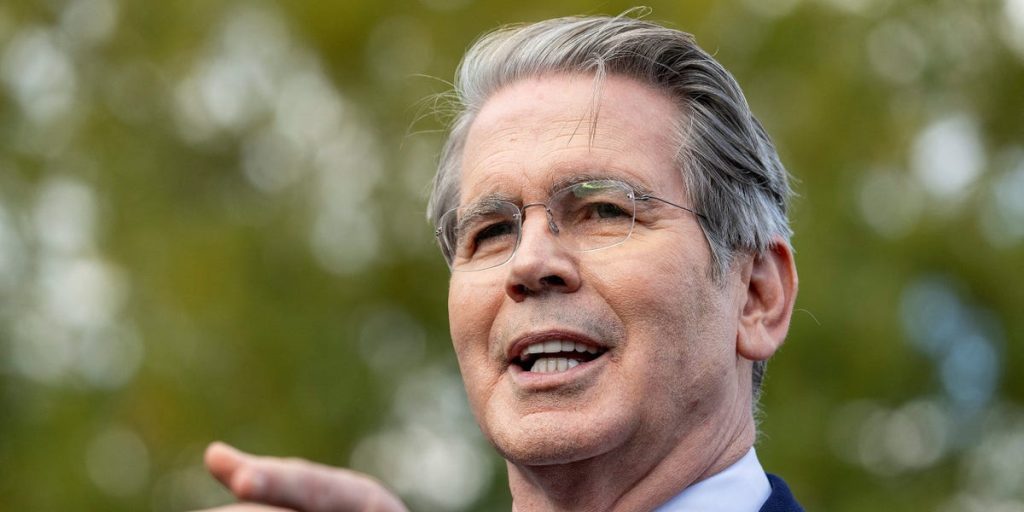Listen to the article
U.S. Treasury Secretary Scott Bessent has labeled a recent Canadian anti-tariff advertisement featuring former President Ronald Reagan as “propaganda” and “psychological operations” against American citizens, escalating tensions in an already fraught trade relationship between the neighboring countries.
Speaking on CNBC’s “Meet the Press” on Sunday, Bessent addressed questions about President Donald Trump’s trade policy decisions, which were reportedly influenced by his displeasure with the controversial ad. The minute-long advertisement, released on October 16 by the Canadian province of Ontario, featured a voiceover of Reagan’s 1987 address defending free and fair trade.
“This is a kind of propaganda against U.S. citizens,” Bessent told CNBC. “It’s psy-ops.”
The Treasury Secretary, who was in Asia with Trump for trade negotiations, questioned the motives behind the advertisement campaign. “Why would the government of Ontario — I’m told that they have spent, or were planning to spend, up to $75 million on these ads to come across the U.S. border,” he said. “So what was the purpose of that other than to sway public opinion?”
In a separate interview on CBS’s “Face the Nation,” Bessent doubled down on his criticism, describing the advertisement as “interference in U.S. sovereign matters” and noting that it had “clearly damaged our relationship with the most populous province in Canada.”
The controversy began when Ontario released the advertisement featuring Reagan’s voice from his 1987 “Radio Address to the Nation on Free and Fair Trade.” The speech argued that while tariffs might appear “patriotic,” they ultimately “hurt every American worker and consumer” and lead to retaliation and trade wars. The message directly contradicted the Trump administration’s protectionist trade policies.
The Ronald Reagan Presidential Foundation and Institute quickly distanced itself from the advertisement, stating on Thursday that Ontario had misrepresented Reagan’s comments and had not sought permission to use or edit the former president’s remarks.
Trump’s response was swift and severe. In a Friday post on his social media platform Truth Social, the president announced he would end trade negotiations with Canada over the advertisement. By Saturday, Trump had escalated the situation further, declaring that he would impose an additional 10% tariff on Canadian goods beyond existing rates, which were already set at 35% for products not covered by the United States-Mexico-Canada Agreement (USMCA).
Ontario Premier Doug Ford attempted to explain the advertisement’s intent in a Friday post on X (formerly Twitter), stating that his aim was to “initiate a conversation about the kind of economy that Americans want to build and the impact of tariffs on workers and businesses.”
“We’ve achieved our goal, having reached U.S. audiences at the highest levels,” Ford wrote. Despite initially planning to continue airing the advertisement during the World Series games over the weekend, Ford later announced that following discussions with Canadian Prime Minister Mark Carney, they would pause the campaign starting Monday to allow trade talks to continue.
The dispute highlights the fragility of the U.S.-Canada trade relationship under the Trump administration, which has previously imposed separate tariffs on various Canadian products including automobile parts. Economic analysts worry that this latest escalation could have significant implications for cross-border commerce, potentially affecting supply chains and consumer prices in both nations.
The controversy comes at a particularly sensitive time, as both countries face economic challenges and political pressures to protect domestic industries. Trade experts note that Canada remains one of America’s largest trading partners, with approximately $2 billion in goods and services crossing the border daily.
As of publication time, representatives for the U.S. Treasury and the Ontario Premier’s Office had not responded to requests for comment on the developing situation.
Verify This Yourself
Use these professional tools to fact-check and investigate claims independently
Reverse Image Search
Check if this image has been used elsewhere or in different contexts
Ask Our AI About This Claim
Get instant answers with web-powered AI analysis
Related Fact-Checks
See what other fact-checkers have said about similar claims
Want More Verification Tools?
Access our full suite of professional disinformation monitoring and investigation tools




6 Comments
Hmm, I can see both sides of this issue. The Canadian government is clearly trying to influence public opinion in the US, but the Treasury Secretary’s response also seems politically charged. It will be interesting to see how this trade dispute plays out between the two countries.
While I understand the Treasury Secretary’s concerns about the ad being ‘propaganda,’ I’m not sure I’d go as far as calling it ‘psy-ops.’ The Canadian government likely has legitimate economic interests at stake. However, the scale of the ad campaign does raise questions about their true motives.
It’s interesting that the Treasury Secretary is calling out the Canadian government’s motives here. $75 million is a substantial investment, so there’s likely more at play than just educating the public. This dispute highlights the complexities of cross-border trade relationships.
This Canadian ad campaign seems like a heavy-handed attempt to sway public opinion on trade policy. While Reagan’s words on free trade are certainly relevant, using them in this way comes across as political propaganda rather than an objective message.
Labeling the ad as ‘psy-ops’ is a strong accusation. While the Canadian government may have strategic reasons for running this campaign, framing it as psychological manipulation seems heavy-handed. There are valid arguments on both sides of the trade debate.
This is a complex geopolitical issue without easy answers. Both the Canadian and US governments seem to be engaging in strategic messaging to sway public opinion. As a neutral observer, I’m curious to see how this trade dispute evolves and whether compromise can be found.